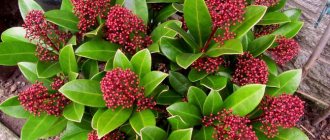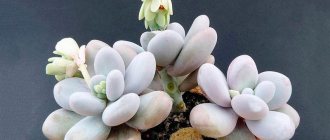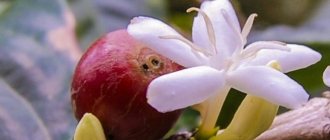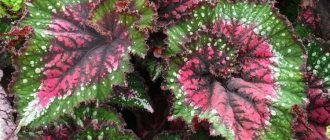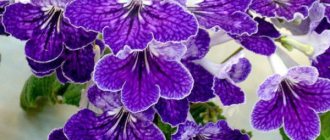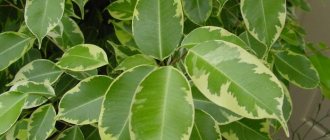Distribution and habitats
The range of balsam includes countries in Africa and Asia, Europe and North America.
But most of the species are still found in tropical rainforests: huge tracts of these plants are concentrated in the green belt of Indochina and Africa, as well as about. Sumatra and Madagascar.
In temperate climates, these plants are found all the way to coniferous taiga forests. For example, in the central regions of Siberia, forest balsam grows, which is a brother of indoor lines.
Did you know? The first specimens of these plants came to Europe in 1596. In fact, home floriculture in its current understanding began from the cultivation of balsams.
Favorite locations are semi-shaded or open areas with moderately moist soils: near trees, along the banks of rivers or streams, as well as near bushes covering ravines.
What to do next?
Above it was described in detail how to grow balsam seedlings from seeds. But that is not all. Next, she needs to provide proper care. The first shoots usually appear after 3 weeks. As soon as this happens, the film or glass can be removed from the pots. If necessary, artificial lighting is installed for seedlings. As it grows, soil is added to the container, and it is also irrigated from a spray bottle with settled water at room temperature. But it is very important not to overdo it with moisture, since its excess can lead to rotting of the rhizome and death of the flower. It is best to water every evening after dusk. If the weather is cloudy and rainy, the intensity of watering is reduced.
If we grow balsam seedlings ourselves, we need to monitor the level of salts in the soil. Their excess can lead to various undesirable phenomena. The presence of problems can be guessed by the appearance of a white coating on the surface of the substrate. If this happens, the only way out is to replant the plant and completely replace the soil. You can avoid excessive salt accumulation by using desalinated or rainwater for irrigation.
Varieties with photos
Waller
It has a number of advantages, one of which is versatility.
On a note. These flowers can be used to decorate not only window sills in houses, but also balconies, flower beds and flower beds.
Has a long flowering period. And unpretentiousness in cultivation complements the list of all advantages.
Double balsam flowers can have different colors: orange, coral, crimson, purple, salmon, red, etc. Some of them have two-tone colors and variegated leaves.
Photo of Waller's balsam.
More nuances about Waller's balsam can be found in our article.
Athena
The pink flowers of this variety can be of different colors: soft pink, coral, red. Some species may be two-colored, such as the unusual red and white coloration. Their size is 4-5 cm. The height in a pot reaches 15 cm, in the garden - up to 30 cm. The plant is compact and blooms for a long time.
Look at the photo of what Athena balsam looks like in pink, red and other colors.
Diseases and pests
If the plant is provided with proper care, the flame will not be damaged by pests. In case of violations of the watering or feeding regime at home, the perennial can quickly be damaged by aphids, meadow bugs, whiteflies and strawberry mites. To destroy these uninvited “guests,” the plants must be treated with insecticides that are harmless to humans: These drugs are Bona Forte, Bitok-sibacillin, etc. When processing, you must follow the processing rules specified in the instructions.
Features of seed storage
In order for the planting material to be of high quality, have a good germination rate and retain the characteristics of the mother plants as much as possible, it must be dry. Therefore, the seeds must be dried before being sent for storage. To do this, they are laid out in matchboxes and left for some time in a dry and well-ventilated area, stirring occasionally.
When storing balsam seeds (we'll tell you how to grow seedlings later), you must follow some rules. Among the main experts are the following:
- Movra is wrapped in paper on which the date of collection is indicated.
- The envelopes are placed in a cool room in which a constant temperature is kept from 0 to 10 degrees Celsius and air humidity is at 60 percent.
If these conditions are met, the seeds are suitable for sowing for 8 years. During this period they maintain their quality and high percentage of germination.
History of origin and botanical description
Origin: the historical homeland of balsam is the tropical and subtropical regions of Africa. Family: balsamaceae.
The story tells of the appearance of balsam in Great Britain in the 16th century. It was presented to Queen Elizabeth I as a flower with “sugar tears” frozen on it. This flower first appeared in Russia at the beginning of the 19th century.
Brief description: Impatiens (lat. Impatiens) is an annual or perennial herbaceous plant. Its stems sometimes reach a height of 50-60 cm. The leaves are lanceolate with serrated edges. After flowering, a fruit is formed - a juicy multi-seeded capsule.
For its some features, the common people received some other names for balsam, such as: “Vanka wet” (due to the droplets of water that appear on the leaves), “Ogonyok” (thanks to the bright flowers).
Home care
Proper care is 99% of success in growing beautiful and healthy plants. Let's consider the main components of proper care.
- Watering. Impatiens need to be watered regularly, preferably with settled water. The frequency of watering in winter is every other day, in summer and in open ground - daily. It is important to spray the leaves occasionally, while avoiding water getting on the flowers. This procedure refreshes the plant well and prevents the appearance of spider mites.
Important! After watering, be sure to drain excess water from the pan.Ignoring this point can lead to rotting of the root system.
- Loosening. Just as all living things need water, air is also necessary.
To ensure air flow into the root system, it is necessary to regularly loosen the soil. This must be done carefully and not very deeply, otherwise the roots may be damaged.
Feeding. Terry balsam needs to be fed year-round, but at different intervals.
From early spring to late autumn, fertilizing is applied once every 10 days. This can be a regular fertilizer for flowering plants, of which the market abounds. It is very good to alternate nitrogen and phosphorus fertilizers. In winter, when growth slows down, once a month will be enough. During this period, it is important that fertilizers contain phosphorus and potassium.- Trimming. When a certain height is reached, terry balsam is pinched from above.
Thanks to this action, new shoots are formed on the sides, the bush becomes lush and beautiful. Regularly remove dried leaves and unhealthy shoots from the terry balsam plant.
Growing and care features
Caring for the plant at home is easy. The prepared soil for planting the fire is loosened by adding humus and fertilizer. Depending on their size, plants are planted at different distances from one another.
When growing balsam, you should adhere to the temperature regime: +15 ° C + 25 ° C, since balsam is very thermophilic.
To make the bushes beautiful, long shoots are cut to half their height before flowering and the branches are pinched until flowering. You can grow a light on any window, regardless of where it faces. The flower will grow equally well.
Transfer
If the impatiens need to be transplanted, this is usually done in mid-spring - early summer. But flower growers need to remember that the light blooms most luxuriantly in a cramped pot. During replanting, old branches are also cut off on the plant to give impetus to the development of young ones. Young plants are replanted annually, and it is possible not to replant, but to transship.
Lighting
The light is a light-loving plant and blooms well only when it grows in an open place. When growing this plant in partial shade, it blooms much less than in the sun. But at the same time, open sunlight suppresses the light. Therefore, it needs to be slightly shaded. The herbaceous shrub can also grow on the balcony on the north side. It only needs a few hours of bright color, at least with a special lamp, and it will bloom vigorously.
Soil composition
Ogonyok feels comfortable on slightly acidic soil, light and permeable. Therefore, in the place where balsams are planted, the best soil mixture will be one consisting of garden soil and sand in a ratio of 3:1. If the soil in the garden is heavy, with a lot of organic matter, it is better to prepare a mixture made up of two parts of earth, the same amount of sand and one part of peat. The top layer of soil needs to be removed, drainage is laid and then the prepared mixture is poured. You can also add approximately as much humus as peat was added.
Watering
Forming significant biomass in a short time, balsams require abundant watering. But with increased amounts of water, the tender roots and the lower part of the stems at the root collar are quickly affected by rot, and the plant may die. Therefore, plants on dense soils need good drainage. Stagnation of water is unacceptable.
In summer, the light needs to be watered almost every day, but in winter this should not be done; watering is carried out as the soil dries.
Air humidity
For any varieties and types of plants, this parameter is not important. But if the temperature of its growing environment becomes higher than 22° C, the bush will have to be moistened by spraying, because the drying fire, losing a lot of moisture from the surface of the leaves, will begin to lose all the moisture that is in it and may dry out , despite watering the soil.
Feeding
Since balsam blooms profusely all season, or even a year, it needs to be fed. Do this every week and a half, alternating organic fertilizers with mineral flower additives. But you should remember that you shouldn’t overfeed the plants. This leads to the fact that they begin to “fatten” and bloom less.
However, you should not overfeed the flower with nitrogen fertilizers. This can cause active growth of stems and foliage, but in this case the gardener will not receive flowers.
Where and how to plant?
Basic landing rules:
- Drainage must be placed at the bottom of the container.
- When replanting, parts of the old root system should be cut off.
- The pruning tool must be disinfected and sharp.
- Treat the sections with crushed activated carbon.
- After the procedure, the plant is placed in a dark place for 2–3 days.
Plants should not be replanted during flowering.
Lighting and location
The best option is a shaded, windless place. Terry balsam is very heat-loving , but does not tolerate direct sunlight, wind and drafts. Therefore, the best place for it is a slope where the sun is several hours a day. The best place in the house is western or eastern windows.
The most destructive thing for a plant is frost!
Soil requirements
The soil must be loose, water- and breathable , and disinfected. This is done using a fungicide or potassium permanganate; you can steam the soil in the oven. Some gardeners advise sifting the soil before planting. A suitable acidity level is 6.0–6.5 units. Heavy clay soils are not suitable for the flower.
The best option is a mixture of leaf and turf soil, peat, humus and river sand. The components are taken in equal parts.
General rules for caring for varietal varieties of Vanka Mokrogo
To prevent balsam from getting sick and to bloom profusely and for a long time, you must adhere to the following rules:
- Drainage is necessary so that the roots do not feel discomfort.
- The soil should be loose, light, and nutritious.
- In summer, the plant needs to be watered every day, but little by little; in winter, once every few days is enough, as the earthen clod dries out. The water should be settled and at room temperature. After watering, excess water is poured out of the pan.
- Impatiens loves the sun, but not direct rays. Depending on the variety, the plant can grow in dense shade or partial shade.
- Impatiens is a heat-loving plant; the air temperature should not fall below +10 degrees.
- It is necessary to fertilize once every 2 weeks after watering with phosphorus-potassium fertilizer.
- For a bush to be attractive, it needs to be shaped periodically.
Impatiens is an ideal indoor and outdoor plant, unpretentious , suitable even for novice gardeners. With proper care, timely replanting and pruning, balsam bushes will delight you with beautiful and unusual flowers and will serve as an ideal decoration for any interior.
Reproduction
Impatiens are propagated indoors using seeds and cuttings.
Cuttings
Cuttings are taken in spring or early autumn from mature plants. They take root very easily, so they are simply planted in sand, which is treated with a solution to accelerate root growth. Or you can plant them directly in the ground. You can also root in water. And sometimes a prepared solution with a stimulant is added to the water and the cuttings are lowered into a vessel with the solution. After 12-13 days, the first roots form.
Seeds
If you need a lot of balsam bushes, then you resort to growing balsam from seeds. The soil mixture for planting seeds is prepared in January or February, no later. The mixture includes leaf soil, humus and sand in proportions 2:2:1. The soil is moistened and small grooves are made. Seeds are placed in the grooves at a distance of 3 cm, seed from seed, and sprinkled with peat or soil on top. Then the container with the seeds is covered with film to create greenhouse conditions. The soil with the planted seeds is placed in a warm place. Until the seeds germinate, the soil is moistened by spraying with a spray bottle or from a tray, but try to prevent waterlogging and fungal infection. When germinating seeds, direct sunlight is unacceptable. After the shoots appear, the container should be moved to a bright place. Shoots usually appear after 10-20 days.
But, despite the fact that under natural conditions the perennial reproduces using seeds, indoors it is difficult to grow flowers using this method. Their germination rate is very low. And the seedlings grow very slowly and often die. Therefore, propagation by cuttings for the fire is most suitable.

